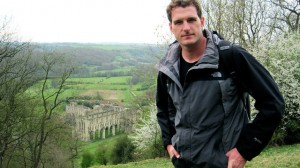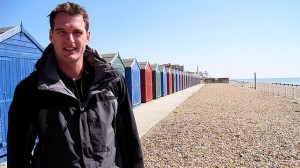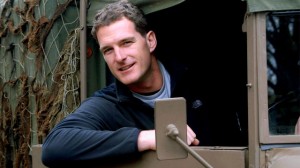From here:

Dan Snow
Filthy Cities
TV historian Dan Snow jokes that his latest project didn’t feel like the easiest way to make a living! Filthy Cities aims to bring to life the stinking histories of London, Paris and New York, with CGI ‘ageing’ the city streets.
Hands-on Dan, 32, goes down into sewers, shovels five tons of horse poo, butchers a pig with a medieval axe, and allows himself to be covered in lice and be bitten by a rat and a leech! TV Choice asks: in heaven’s name why?!
Er, Dan, what an unusual idea for a programme…
“It’s a rancid idea! But I’ve always been interested in waste and our society. Basically, human beings create the seeds of our own destruction. Our waste has the capacity to destroy us, and that’s quite a weird idea, really. We can only really live in these big cities because we’ve worked out ways to get rid of this waste, and so I wanted to go back and look at the medieval city, the early modern city and the very modern city to see how we’ve overcome these giant problems.”
The first programme looks at London. What was it like in medieval times?
“London was particularly bad. They had to put all the muck in carts and take it out to the fields, they’d chop up animals and empty the entrails into the Thames, which became one vast sewer. And, of course people would wash in the Thames and they’d get cholera. Conditions were unspeakably horrible.”
You actually stand in London’s River Fleet, which some people won’t know about.
“Yes, the river’s still there, it’s just confined into a tiny little sewer underground now. The thing about the Fleet is that it got so choked up with sewage that it actually stopped running as a river. Newgate Prison was there, and the smell and the disease were so unbelievably bad that medieval Londoners started worrying about the health of the prisoners!”
Was it difficult getting permission from city councils for some of the stunts in the series?
“It was a heck of a series to work on. You can imagine how hard it is to get five tons of horse manure dumped on a busy City of London street, or how to get the New York council to put a 6ft high block of frozen horse poo on the street to show what it would have been like in winter in the 19th century! But I was learning new stuff endlessly, it was absolutely fascinating.”
But didn’t you baulk at some of the things the producers got you to do, like being bitten by a rat?
“I baulked at everything, really! I went into a flat in New York where a mentally ill woman had shut herself in for 30 years, and the flat was full of human waste and rats and lice and all sorts of nasty things. So that was very unpleasant.”
Martina Fowler


 As part of the BBC’s Norman season, historian Dan Snow puts his walking boots on and sets off to see what the great British landscape can teach us about our Norman predecessors. From their violent arrival on these shores, to their most sustaining legacies, Dan’s three walks follow an evolutionary path through the Normans’ era from invasion, to conquest, to successful rule and colonization.
As part of the BBC’s Norman season, historian Dan Snow puts his walking boots on and sets off to see what the great British landscape can teach us about our Norman predecessors. From their violent arrival on these shores, to their most sustaining legacies, Dan’s three walks follow an evolutionary path through the Normans’ era from invasion, to conquest, to successful rule and colonization. As part of the BBC’s Norman season, historian Dan Snow puts his walking boots on and sets off to see what the great British landscape can teach us about our Norman predecessors. From their violent arrival on these shores, to their most sustaining legacies, Dan’s three walks follow an evolutionary path through the Normans’ era from invasion, to conquest, to successful rule and colonization.
As part of the BBC’s Norman season, historian Dan Snow puts his walking boots on and sets off to see what the great British landscape can teach us about our Norman predecessors. From their violent arrival on these shores, to their most sustaining legacies, Dan’s three walks follow an evolutionary path through the Normans’ era from invasion, to conquest, to successful rule and colonization. To mark the 70th anniversary of the ‘miracle of Dunkirk’, 50 of the surviving little ships which made the original perilous cross-channel voyage are returning to France. Dan Snow tells their extraordinary story: their role in the evacuation and the people who struggled to keep them afloat during those fateful days in 1940, when the future of Europe hung in the balance.
To mark the 70th anniversary of the ‘miracle of Dunkirk’, 50 of the surviving little ships which made the original perilous cross-channel voyage are returning to France. Dan Snow tells their extraordinary story: their role in the evacuation and the people who struggled to keep them afloat during those fateful days in 1940, when the future of Europe hung in the balance.